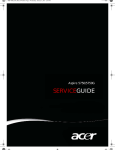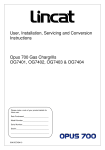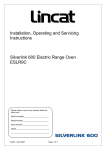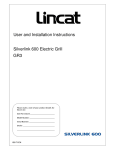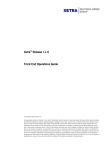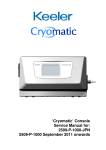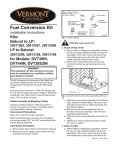Download manual
Transcript
Installation, Operating, Servicing and Conversion Instructions Silverlink 600 Gas Ranges SLR6, SLR6C, SLR9 and SLR9C Please make a note of your product details for future use: Date Purchased:_________________________ Model Number:__________________________ Serial Number:__________________________ Dealer:_________________________________ _______________________________________ IS 514 ECN 3706 Page 1 of 20 CONTENTS Important Information Warnings and Precautions Technical Data Checklist of Enclosures Installation and Commissioning Operating Instructions Cleaning Servicing, Maintenance and Component Replacement Conversion Fault Finding Spare Parts List Accessories Service Information and Guarantee 2 3 4 5 6 7 9 10 15 17 18 19 20 IMPORTANT INFORMATION Read these instructions carefully before using this product, paying particular attention to all sections that carry warning symbols, caution symbols and notices. Ensure that these are understood at all times. WARNING! This symbol is used whenever there is a risk of personal injury. CAUTION! This symbol is used whenever there is a risk of damaging your Lincat product. NOTE: This symbol is used to provide additional information, hints and tips. KEEP THIS MANUAL FOR FUTURE REFERENCE IS 514 ECN 3706 Page 2 of 20 WARNINGS AND PRECAUTIONS This appliance must be installed, commissioned, serviced and converted by a qualified person in accordance with national and local regulations in force in the country of installation. Strip plastic coating and clean the appliance before use. During operation parts may become hot - avoid accidental contact. Parts protected by the manufacturer shall not be adjusted by the user. Do not obstruct or block the flue. Installation must include sufficient ventilation to prevent the occurrence of unacceptable concentrations of substances harmful to health in the room in which they are installed. After operation, some parts of the appliance will remain hot for a period of time. Please take care to avoid accidental burns. IS 514 ECN 3706 Page 3 of 20 TECHNICAL DATA Model SLR6 Dimensions Overall height (mm) Width (mm) Depth (mm) Weight (kg) Hob cooking surface w x d (mm) Usable oven capacity w x d x h (mm) Oven shelf size (mm) 960 to pan support 900 600 69kg (Net) 85kg (Net) 590 x 500 890 x 500 425 x 345 x 400 660 x 345 x 400 420 x 345 700 x 345 Heat Input Total heat input Natural(Gross) Total heat input Propane(Gross) Total heat input Butane(Gross) Oven rating Natural(Gross) Oven rating Propane(Gross) Oven rating Butane(Gross) Hob rating, per burner Natural(Gross) Hob rating, per burner Propane(Gross) Hob rating, per burner Butane(Gross) Hob Low Rate (all gasses) Connection and Operating Pressures Gas inlet connection Supply Pressure - Natural Supply Pressure - Propane Supply Pressure - Butane Gas Consumption Total gas rate – Natural Total gas rate – Propane Total gas rate – Butane Hob burner gas rate - Natural Hob burner gas rate - Propane Hob burner gas rate - Butane Oven burner gas rate - Natural Oven burner gas rate - Propane Oven burner gas rate - Butane Hob Low Rate Natural Hob Low Rate Propane Hob Low Rate Butane 925 to hob 600 23.8 kW 23.8 kW 20.6kW 5.8 kW 5.8 kW 5.8 kW 35.5kW 35.5kW 30.7kW 8.5 kW 8.5 kW 8.5 kW 4.5 kW 4.5 kW 3.7kW ≈ 0.85kW RP½ (½" BSP) 20mbar 37 mbar 28-30mbar 2.27 m3 h-1 3.38 m3 h-1 1.70 kg h-1 2.54 kg h-1 1.50 kg h-1 2.23 kg h-1 3 -1 0.43m h 0.32kg h-1 0.27kg h-1 0.55m3h-1 0.81m3h-1 0.41kg h-1 0.61kg h-1 -1 0.42kg h 0.62kg h-1 ≈0.08m3h-1 ≈ 0.06kg h-1 ≈ 0.06kg h-1 Oven temperature range IS 514 ECN 3706 SLR9 ≈130 – 250 °C Page 4 of 20 CHECK LIST OF ENCLOSURES Model Warranty Card Pan Supports User Instructions IS 514 ECN 3706 SLR6 1 2 1 SLR9 1 3 1 Page 5 of 20 Tick INSTALLATION AND COMMISSIONING Site this appliance beneath an extraction canopy for the removal of combustion products. Installation must include sufficient ventilation to prevent the occurrence of unacceptable concentrations of substances harmful to health in the room of installation. There must be a minimum free area of 4.5cm2 per kW of total heat input. Allow for a sufficient flow of fresh air for complete gas combustion. Do not connect directly to any flue, ducting or mechanical extraction system. The gas supply hose or tubing shall comply with national requirements in force and shall be periodically examined and replaced as necessary. An equipotential bonding terminal is provided to allow cross bonding with other equipment. Install this appliance on a level surface ensuring all vents are unobstructed. Any partitions, walls or furniture must be of non-combustible material and not be closer than 50mm Ensure there is a space of at least 1000mm between the working surface and any ceiling. GAS SUPPLY AND CONNECTION Connection is at the rear of the unit via a Rp½ (½" BSP) When making the connection to the appliance an isolating cock should be fitted into the supply line close to the unit, for emergency shutdown or servicing purposes. SUPPLY PRESSURES The appliances are intended to be connected directly to the gas supply without further adjustment for those countries where the supply pressure does not exceed the pressures as detailed above. For those countries where the supply pressures exceed the pressures as tabled then the supply pressure must be regulated to the pressures as detailed above. For the purposes of proving connection integrity access to the pressure test nipple is as follows: • To gain access to the gas pressure test nipple open the oven door/s. • Remove the control knobs. • Remove the anti-tamper screws securing the fascia • Remove the oven ignitor lead. • The test nipple is found on the manifold rail. FIRST TIME LIGHTING The procedure for first time lighting may only be carried out by registered personnel. To light any individual burner it may be necessary to purge all pipe work of air. To do this, depress and hold in the full on position as many controls knobs as possible until there is evidence of free gas flow. Upon detection of gas flow return all but one control knobs to the 'OFF' position and light the gas at the burner corresponding to the control knob in the depressed position. When the gas at the burner is burning correctly shut it down and repeat the lighting process for the remaining burners. IS 514 ECN 3706 Page 6 of 20 OPERATING INSTRUCTIONS Only qualified or trained personnel should use this appliance. LIGHTING SEQUENCE Please ensure that the gas isolation valve for the appliance is turned to the open position before attempting to light this unit. Hob Burners From the OFF position: press and turn the control knob anti-clockwise to any position between the two stylized flames to allow gas through to the burner. Maintaining the control knob depressed, manually light the gas at the burner using a taper or piezo ignitor wand. On establishing a flame at the burner, keep the knob depressed for approximately 15 seconds then release. The burner should remain lit. If the appliance has stood unused for any length of time it may be necessary to purge the burner feed pipes of air. To purge the burner feed pipes of air depress and rotate a control knob to the full on position. Maintain the knob in the depressed position for 2030seconds and then light the gas at the burner. Repeat as necessary until the gas ignites. Oven Burner Open the oven door/s From the OFF position press and turn the oven thermostat knob anti-clockwise to the stylized star position to allow gas to flow through to the oven burner. Maintaining the control knob depressed, push the oven ignitor button until an audible click is heard. A spark will be generated at the oven burner. The gas at the oven burner should light. It may be necessary to repeat the ignition process a number of times until the gas lights. On establishing the flame at the oven burner, maintain the thermostat knob in a depressed state for approximately 15 seconds and then release the control knob. The gas should remain lit. Rotate the thermostat knob to the desired temperature setting. USING THE APPLIANCE Ensure the pan supports are centrally placed on the hob to. It is recommended that a burner is lit first before placing large pans over the burner. It is not recommended that multiple lit burners are covered at any one time by large gastronome pans or detachable griddle plates. PAN PLACEMENT Pans should be placed centrally on the pan support in relation to the burner for maximum efficiency. PAN SIZES The recommended pan base diameters are no smaller than 150mm and no larger than 400mm. Pans should never be placed in such a position that they become a hazard from tipping IS 514 ECN 3706 Page 7 of 20 Oven Temperatures NOTE The temperatures on the thermostat knob are a guide and generally reflect the temperature at the centre of the oven. The temperatures in the oven will vary from top to bottom. It may be necessary to periodically rotate product being cooked to ensure even cooking. OPERATION OF THE APPLIANCE • The appliance should not be left unattended when in use for any lengthy period of time. • Pans should only be filled to a level no more than to prevent a boil over situation. • Periodically inspect liquid volumes to prevent a boil dry situation. • Frying of product should never be left unattended. • Use hand and arm protective when handling hot pans to avoid injuries from burns. . OVEN DOORS • Care must be taken when opening the oven doors when the appliance is in operation due to the rapid escape of hot air. • Use hand and arm protective when handling hot roasting pans and baking trays to avoid injuries from burns. IS 514 ECN 3706 Page 8 of 20 CLEANING Do not use a water jet or steam cleaner, and do not immerse this appliance. Clean all panels with warm water and mild detergent, do not use abrasive materials. Dry with a soft cloth. It is important that users of the appliance systematically check and clean down as necessary areas of the hob and oven cavity that have accumulated oils, fats and other combustible debris from previous cooking. Particular attention must be paid to the burner head ports. Ensure they are always clear. Ensure the appliance and all its parts are in a cold state before commencing any cleaning routine. Areas to Check • Burner Caps – Check burner caps are clean and centrally seated on the burner head • Burner Heads – The burner heads can only be fitted in one orientation onto the burner body. As a guide the recess with the two ports aligns with the thermocouple. • Pan Supports – The pan supports are manufactured from cast iron and are heavy. For ease of cleaning they can be removed from the appliance and placed in a suitable dish washer. • Oven Shelves – The shelves can easily be removed for routine cleaning. Stubborn burned on deposits can be cleaned using suitable approved cleaning agents and scourers • Oven Base Tray – Can be easily removed for cleaning • Oven Cavity – To clean the oven cavity remove the shelves and base tray and remove any solids and accumulated fats, oils and spillages. IS 514 ECN 3706 Page 9 of 20 SERVICING, MAINTENANCE AND COMPONENT REPLACEMENT The replacement of serviceable parts can only be carried out by registered authorised personnel and must and must be in possession of up to date licensing. FASCIA PANEL REMOVAL Care should be taken when removing the fascia panel as the oven ignitor lead will be attached to the ignitor. • Open the oven door/s • Remove the screws SS situated underside of the fascia panel FF. • Remove the control knobs CC by pulling free from the valve spindles. Be aware spring clips are fitted to each control knob • Tilt the fascia panel from the bottom up and then pull clear of the hob top. • Disconnect the ignitor lead from the ignitor button and temporarily tie to the manifold rail. • Access to the valves, thermostat, pipe work and thermocouples are from the front aperture FF CC SS Fig1 OPERATIONAL CHECK Commissioning must include an operational check of all controls. • • Check that each burner can be lit at both full rate and low rates Check that each burner will remain lit when turned to low rate IS 514 ECN 3706 Page 10 of 20 Hob Burner Components Isolate the gas supply to the appliance To replace the burner and its parts: Remove the burner cap 'BU09' Remove the burner head 'BU08' Remove the 3 screws 'FAS601 Remove the control knobs from the valves Remove the fascia panel Loosen the burner feed pipe connection nut on 'CO15' Loosen the thermocouple nut 'TC01' connection at the corresponding valve Remove the burner body 'BU07' and the gasket 'FAS351' Remove the injector 'JExx' (dependent on gas type) from the burner body Remove the thermocouple 'TC01' from the burner body Remove the remaining section of the 'CO15' from the burner body. Note: When replacing CO15 a suitable gas tight thread sealant must be used Replace and reassemble any or all parts as applicable Reconnect the gas supply Perform leak test to prove integrity of joints BU09 BU08 FAS601 JEXX FAS351 BU07 CO15 TC01 Fig 2 Valve Components Isolate the gas supply from the appliance To remove the valve and its parts: Remove the control knobs Remove the fascia panel Loosen the thermocouple 'TC01' nut at the valve body 'VA10' Loosen the burner feed pipe nut 'BU159' at the valve Remove the valve clamp screw 'BU209' Lift the valve clamp 'BU208' from the valve and the manifold 'MAxx' (dependent on appliance) Free the valve from the manifold Replace and reassemble parts as necessary Reconnect the gas supply Perform leak test to prove integrity of joints IS 514 ECN 3706 BU209 BU208 MAxx BU159 VA10 BU158 Fig 3 Page 11 of 20 Oven Burner Components Ignitor Electrode To remove the ignitor (IG16) electrode remove the lead from the electrode Remove the retaining screw FAS360 and nut FAS016 Replace the ignitor, secure and refit the lead Thermocouple Loosen the lock nut at the tip side of the thermocouple (TC33) and withdraw from the burner bracket Remover the control knobs and fascia panel Loosen the thermocouple nut at the thermostat Bind the new thermocouple thermostat end to the tip of the old thermocouple and gently feed old and new through into position Remove the binding and the old thermocouple Make good the thermocouple connection at the thermostat Lock the thermocouple head to the burner bracket to the dimensions details. See thermocouple setting Oven Burner Isolate the gas supply from the appliance Remove the thermocouple and ignitor electrode Remove the burner injector ( see Gas Conversion) Remove the burner retaining screws Replace the new burner and refit parts Reconnect the gas supply Check joints for leak free integrity FA S 609 FA S 630 IG 1 6 FA S016 T C 33 B U xx J E xx W A 13 CO 133 IS 514 ECN 3706 Page 12 of 20 Fig 4 Thermocouple Setting To correctly position the thermocouple the lock nuts will require setting on the barrel of the thermocouple body Feed the replaced thermocouple as detailed above Position the thermocouple as detailed below and to the dimension given Lock the thermocouple into place Light the oven burner and set the thermostat to approximately 190oC Allow the oven to reach temperature with the doors shut and turn the thermostat to the lowest setting (1301oC) Check that the flame remains established at the burner If the flame at the burner at the lowest setting drops out minor adjustments may be necessary to maintain the flame BUxx T C 33 IS 514 ECN 3706 38 ±1 Fig 5 Page 13 of 20 Thermostat Replacement Isolate the gas supply to the appliance To replace the thermostat remove the control knobs and fascia panel Supporting the thermostat body and loosen the thermostat feed nut TH17C Loosen the clamp screw FAS150 and lock nut FAS033 sufficiently to free the thermostat brackets TH17k and TH17L Free the thermostat TH17A from the manifold Maxx Free the thermocouple TC33 from the thermostat body Free the thermostat bulb from the oven cavity bracket (remove oven shelves to ease access) Feed the thermostat bulb and capillary through the top of the oven cavity liner Withdraw the thermostat Connect the thermocouple to the new thermostat Fit the new thermostat to the manifold and secure ensuring the seal is fitted to the saddle of the thermostat Carefully unwind the capillary and feed the thermostat bulb through the top of the liner and reset the bulb in its bracket. Ensure all capillary slack is fed back above the top liner Make good the gas feed connection nut to the thermostat. Reconnect the gas supply Check joints for leak free integrity Refit the fascia panel and control knobs Check the low flame function of the oven burner as detailed in thermocouple setting MAxx TH17C TH17K FAS033 TH17L FAS150 TH17A TUxx TC33 IS 514 ECN 3706 Fig 6 Page 14 of 20 CONVERSION Hob Burner Injector Changes Inlet Model Gas Pressure G20 20mbar All G30 28-30mbar G31 37mbar Oven Burner Injector Changes Inlet Model Gas Pressure G20 20mbar SLR6 G30 28-30mbar G31 37mbar G20 20mbar SLR9 G30 28-30mbar G31 37mbar ∅ Mark Part Number 1.64 0.98 1.10 164 98 110 JE155 JE157 JE156 ∅ Mark Part Number 1.90 1.25 1.25 2.40 1.50 1.50 190 125 125 240 150 150 JE107 JE109 JE109 JE50 JE51 JE51 Burner Injector The burner injector is fitted to the base of the burner body Remove the burner cap 'BU09' Remove the burner head 'BU08 Access to the burner injector 'JExx' is through the venturi to the base of the burner body 'BU07'. To remove un-screw by turning anticlockwise The correct size of the injector appertaining to gas type is marked on one of the hexagonal faces of the injector. Replace with the correct injector applicable to gas type and reassemble burner parts BU09 BU08 JExx BU07 Fig 7 Hob Burner Bypass Injector Adjustment Remove the control knobs Adjustment for conversion from Natural gas to Propane or Butane: Rotate the bypass injector clockwise full home, do not over tighten. Replace the control knobs Adjustment for conversion from Propane or Butane to Natural gas : Ensure the bypass injector is fully home, do not over tighten Rotate the bypass injector between 1/3 to 1/2 of a turn anticlockwise Replace the control knobs IS 514 ECN 3706 Page 15 of 20 Fig 8 Oven Burner To replace the oven burner injector Loosen the nut on the feed elbow CO133 Free the elbow and injector from the burner BUxx Free the injector JExx from the elbow Replace the injector applicable to the gas type with the washer WA13 and tighten against the elbow Refit the injector assembly to the burner Reconnect the elbow nut Check joints for leak free integrity TC33 IG16 WA13 CO133 JExx BUxx Fig 9 Replace gas specific labels for which the appliance has been converted Replace data plate corresponding to gas type IS 514 ECN 3706 Page 16 of 20 FAULT FINDING • Piezo oven ignitor not sparking Check for a Short in High Tension Lead Yes Lead Detached No Replace Lead Reconnect Lead Check Electrode for Fracture • Yes No Replace Electrode Replace Piezo Ignitor Burner/s will not light or stay lit Is There Gas at the Burner? Yes No Check Injector for Blockages Yes No Are Thermocouple Connections Loose? Tighten Connections Yes Is the Thermocouple Voltage Less than 5mV? Replace Thermocouple Yes Replace Valve IS 514 ECN 3706 Page 17 of 20 No Is the Valve Damaged? Recheck System No SPARE PARTS LIST Description Hob burner body Hob Burner head Hob burner cap Door bush Oven burner – SLR9 Oven burner – SLR6 Fixed castor Adjustable leg Piezo ignitor Ignitor electrode Ignitor lead Manual of Instruction Oven injector (Natural) SLR6 Oven injector (Propane) SLR6 Oven injector (Butane) SLR6 Hob injector (Natural) Hob injector (Propane) Hob injector (Butane) Oven injector (Natural) SLR9 Oven injector (Propane) SLR9 Oven injector (Butane) SLR9 Thermostat control knob Hob control knob Pan support Oven shelf SLR6 Oven shelf SLR9 Side rack ovens Hob thermocouple Oven thermocouple Thermostat (complete) Hob Valve (complete) Copper Washer IS 514 ECN 3706 Part number BU07 BU08 BU09 BU55 BU78 BU86 CA86 FE29 IG12 IG16 IG18 IS08 JE107 JE109 JE109 JE155 JE156 JE157 JE50 JE51 JE51 KN191 KN196 PA25 SH87 SH88 SR11 TC01 TC33 TH17 VA10 WA13 Page 18 of 20 ACCESSORIES Part Number IS 514 ECN 3706 Description Page 19 of 20 Used on SERVICE INFORMATION For help with the installation, maintenance and use of your Lincat equipment, please contact our service department: UK: 01522 875520 For non-UK customers, please contact your local Lincat dealer All service work, other than routine cleaning should be carried out by one of our authorised service agents. We cannot accept responsibility for work carried out by other persons. To ensure your service enquiry is handled as efficiently as possible, please tell us: • • • • Brief details of the problem Product code All available on serial plate Type number Serial number Lincat reserve the right to carry out any work under warranty, given reasonable access to the appliance, during normal working hours, Monday to Friday, 08:30 to 17:00. GUARANTEE This unit carries a comprehensive UK mainland twelve month/2 year warranty. The guarantee is in addition to, and does not diminish your statutory or legal rights. The guarantee does not cover: • • • Accidental damage, misuse or use not in accordance with the manufacturer’s instructions Consumable items Damage due to incorrect installation, modification, unauthorised service work or damage due to scale, food debris build-up, etc. The manufacturer disclaims any liability for incidental, or consequential damages. Attendance is based on reasonable access to the appliance to allow the authorised technician to carry out the warranty work. Service calls to equipment under warranty will be carried out in accordance with the conditions of sale. Unless otherwise specified, a maximum of 15 minutes of administrative time, not spent directly carrying out servicing work, is provided for within the warranty. Any requirement for staff attending the call to spend greater time than 15 minutes due to administrative requirements, such as on health and safety risk assessments, will be chargeable at the prevailing rate. IS 514 ECN 3706 Page 20 of 20




















